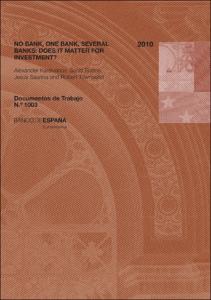Registro completo de metadatos
| Campo DC | Valor |
|---|---|
| dc.contributor.author | Karaivanov, Alexander |
| dc.contributor.author | Ruano, Sonia |
| dc.contributor.author | Saurina, Jesús |
| dc.coverage.spatial | España |
| dc.date.accessioned | 2019-08-10T17:57:11Z |
| dc.date.available | 2019-08-10T17:57:11Z |
| dc.date.issued | 2010-03-22 |
| dc.identifier.issn | ISSN: 0213-2710 (en papel) |
| dc.identifier.issn | ISSN: 1579-8666 (en línea) |
| dc.identifier.uri | https://repositorio.bde.es/handle/123456789/7024 |
| dc.description.abstract | This paper examines whether financial constraints affect firms’ investment decisions for older (larger) firms. We compare a group of unbanked firms to firms that rely on formal financing. Specifically, we combine data from the Spanish Mercantile Registry and the Bank of Spain Credit Registry (CIR) to classify firms according to their number of banking relations: one, several, or none. Our empirical strategy combines two approaches based on a common theoretical model. First, using a standard Euler equation adjustment cost approach to investment, we find that single-banked firms in our sample are most likely to exhibit cash flow sensitivity while unbanked firms are not. Second, using structural maximum likelihood estimation, we find that unbanked firms have a financial structure which is close to credit subject to moral hazard with unobserved effort, whereas single-banked firms have a financial structure which is more limited, as in an exogenously imposed traditional debt model. Firms in the unbanked category do not rely on bonds, equity, or formal financial markets, but rather on other firms in a financial or family-tied group (with either pyramidal or informal structure). We are among the first to document the importance of such groups in a European country. We control for reverse causality by treating bank relationships as endogenous and/or by appropriate stratifications of the sample |
| dc.format.extent | 60 p. : tab., gráf. |
| dc.language.iso | en |
| dc.publisher | Banco de España |
| dc.relation.ispartof | Documentos de Trabajo / Banco de España, 1003 |
| dc.rights | Reconocimiento-NoComercial-CompartirIgual 4.0 Internacional (CC BY-NC-SA 4.0) |
| dc.rights | In Copyright - Non Commercial Use Permitted |
| dc.rights.uri | https://creativecommons.org/licenses/by-nc-sa/4.0/deed.es_ES |
| dc.rights.uri | http://rightsstatements.org/vocab/InC-NC/1.0/ |
| dc.subject | Financial constraints |
| dc.subject | Bank lending |
| dc.subject | Investment Euler equations |
| dc.subject | Moral hazard |
| dc.subject | Structural estimation and testing |
| dc.title | No bank, one bank, several banks : does it matter for investment? |
| dc.type | Documento de trabajo |
| dc.identifier.bdebib | 000275103 |
| dc.identifier.bdepub | DTRA-201003-eng |
| dc.subject.bde | Créditos |
| dc.subject.bde | Financiación de la empresa |
| dc.subject.bde | Instituciones crediticias de depósito |
| dc.publisher.bde | Madrid : Banco de España, 2010 |
| dc.subject.jel | C61 |
| dc.subject.jel | D82 |
| dc.subject.jel | D92 |
| dc.subject.jel | G21 |
| dc.subject.jel | G30 |












